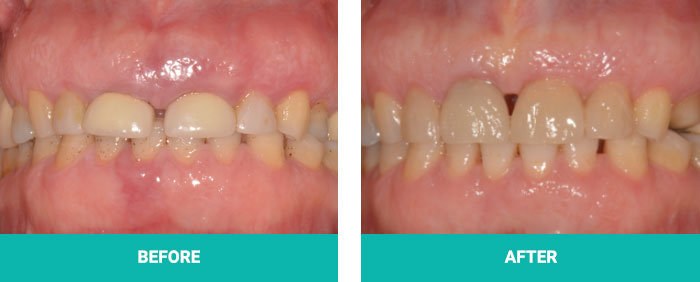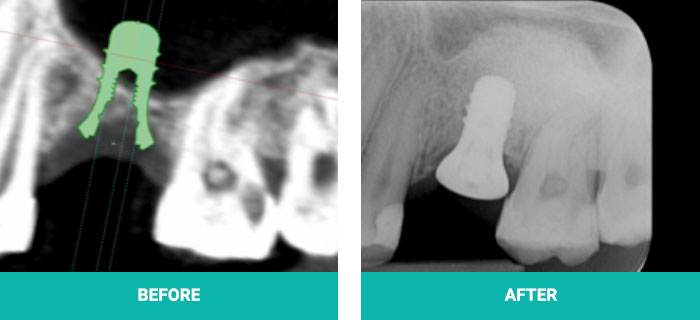PROCEDURES
Crown Lengthening and Gum Lifts
Using the latest minimally invasive surgical techniques in periodontal therapy, crown lengthening can be done to create an aesthetically pleasing smile where the teeth have the correct proportions.
Dr Jeremy Vo can work in collaboration with your dentist to plan the perfect smile, particularly if you need additional orthodontic treatment or veneers.
What is Crown Lengthening?
Crown lengthening is a surgical procedure that involves removing or displacing gum tissue. It is often done in order to expose more of the tooth above the gumline, thus addressing the appearance of excess gum tissue and a ‘gummy smile’.
As a restorative dental procedure, crown lengthening can be done for aesthetic purposes or to prepare for another dental procedure, such as tooth crowning. Crown lengthening can also be done to expose more of the tooth in order to reduce or prevent tooth decay.

The Purpose of Crown Lengthening Surgery - What is it For?
Crown lengthening surgery might be done for one of a number of reasons. It can be done to improve the appearance of excess gum tissue and provide a more symmetrical smile, making the teeth appear longer and more balanced. It can also be done to expose cavities, decay or broken areas of teeth; or to expose more tooth structure in preparation for another dental procedure, such as tooth crowning.
Gummy Smile
A gummy smile refers to a smile that reveals excess gum tissue. This can lead to an un-aesthetic smile. One such cause of a gummy smile is when the gums excessively grow over the teeth, leading to the appearance of small teeth. Fortunately, this situation can be easily enhanced with a minor gum procedure called crown lengthening.
A gummy smile can occur as a result of genetics - for example if you have a larger upper jaw than usual - or due to other factors such as poor dental hygiene. Reasons why you might develop a gummy smile include:
- Teeth that have erupted too far downward and have dragged the gums down with them
- Teeth that have worn down over time
- A hyperactive lip that lifts high enough to expose more gum tissue than usual
- An usually large upper jaw
Crown lengthening surgery can help to improve the appearance of a gummy smile.
Gum Recession
Gingival recession, or receding gums, can be identified by the exposure of the roots of your teeth. Although a receding gum line is more common in adults over the age of 40, it can also happen among teenagers or older children aged 10 and up. It can also occur in young adults after orthodontic treatment.
The most common symptom of gum recession is increased sensitivity to hot and cold foods, but if left untreated the appearance of your smile can be altered due to the illusion of ‘longer’ teeth.
Fortunately, periodontists such as Dr Jeremy Vo can restore your gums’ health and reverse gum recession.
Causes of Receding Gums
The most common causes of receding gums include:
- Brushing too hard with a scrubbing technique. Scrubbing too hard can cause the enamel at the gum line to be worn away.
- Flossing too aggressively may also cut into the gums.
- Gum disease
- Excessive frenal attachments
In more severe cases, a gum graft can be utilised to cover the exposed root surface and help protect the longevity and appearance of your tooth.

Do I Require Crown Lengthening?
There are a few main reasons why you be a good candidate for crown lengthening surgery, including:
- If you need to repair your teeth as a result of trauma or gum disease
- If you desire a more symmetrical smile and are worried about the appearance of your gums
- If you are getting a cosmetic dental crown and there’s not enough of the tooth exposed for this procedure to be done comfortably
You should discuss this with your dentist to discern whether or not crown lengthening is right for you.
What Does a Crown Lengthening Procedure Involve?
There are a few different techniques for crown lengthening procedures that require slightly different processes. In each case, the treatment involves a dentist removing or reshaping gum tissue and possibly bone tissue as well.
Gingivectomy (Gum Contouring)
A gingivectomy procedure is the removal of gum tissue using a scalpel, laser or electrically heated instrument. Local anaesthetic will be used and a few days recovery time will usually be needed.
A gingivectomy can help to shorten the height of the gums and create more symmetry in the gum line, and the soft tissue should be healed within 4-6 weeks.
Apically Repositioned Flap Surgery
In this procedure, the dentist creates a flap of tissue in the gums by making a small incision. Tissue is then removed from beneath this flap and the flap is stitched closed.
Surgical Extrusion
Surgical extrusion involves specifically repositioning a tooth to be further above the gumline - in a more supra gingival position. This procedure is usually done when the tooth in question has been damaged or fractured. The dentist may use stitches that will dissolve over time, or the stitches may need to be removed at a later appointment.
Bone Grafting
One of the main requirements for dental implants is the volume of available bone to allow successful and safe implant installation. However, one of the consequences of tooth loss is also the long term loss of supporting jaw bone. This can complicate dental implant surgery. To regrow your lost bone tissue, periodontists perform a procedure called bone grafting to make implant treatment possible and safer. Dr Jeremy Vo is specially trained in bone grafting techniques.
Bone Grafting Technique
- First your bone levels are determined with 3D imaging for accurate and precise measurements.
- Several different types of bone grafts are available. Dr Jeremy Vo will discuss with you what is the most suitable material to use.
- We will use local anaesthesia if it is a minor procedure. Bone grafting material is added over the top of your own bone which in turn stimulates your body to produce more bone.
- The maturation of the bone graft can take between 3-9 months.
Once the bone graft has matured, the benefits of bone grafting include:
- Stronger and better bone volume to support the implant
- Improve the aesthetics of your smile with a ‘fuller’ appearance of your jaw
- Reduce the risk of future implant installation going wrong

Tissue Grafts
A gum tissue graft is often performed to protect your mouth from the effects of gum recession, and can also help to improve the appearance of your gums. It is a different process to crown lengthening, because it usually aims for the opposite results (more gum tissue as opposed to less).
There are three different techniques used for gum tissue grafts:
- Connective tissue grafts
- Free gingival grafts
- Pedicle grafts
Gingival Coloured Composite Resin
Another method of addressing gum recession is to apply a composite resin to the gums in order to cosmetically improve the appearance of the gums and cover the roots of the teeth. This method involves selecting a colour that matches the gums of the patient, applying an adhesive and then attaching the gingival composite.
These restorations are able to increase the size of the gums without the need for gum tissue graft surgery.
Tissue Stimulation
Tissue stimulating proteins can be used to help regenerate gum tissue and improve support after bone grafting surgery. These aids can be used to restore lost or damaged tissue after being treated for gum recession or bacteria growth.
The Crown Lengthening Treatment Process
Preparing for a Crown Lengthening Treatment
Before committing to a crown lengthening procedure, you should discuss your concerns with your dentist to determine whether or not it’s right for you.
In preparation for crown lengthening treatments, you should maintain good levels of dental hygiene, including:
- Brushing and flossing regularly
- Having regular dental check ups
- Using mouthwash
Before the surgery, you will have a periodontal consultation in which the periodontist will perform an analysis to determine the size and shape of the new gum line that is appropriate for your mouth.
What to Expect During Surgery
During a crown lengthening treatment, a periodontist or dentist will remove excess gum tissue from your mouth.
The procedure will depend on the technique that is selected for you based on your individual needs. Three of the most common techniques are:
- Gingivectomy
- Apically repositioned flap surgery
- Surgical extrusion
The technique that the periodontist selects for you might be based on:
- The aesthetics you desire
- The crown to root ratio in your mouth
- The proximity and appearance of the root
- The position of the teeth along the gum line
- The reason for the surgery
Crown Lengthening Aftercare and Recovery
The type of aftercare that is required will depend on the technique that was used, so your dentist will advise you on what to do during your recovery.
The procedure itself should not be painful because anaesthetic will be used, but you may experience some minor pain, bleeding and swelling for a few days afterwards. Your dentist may recommend that you take anti-inflammatory medication, use a cold compress or use antiseptic mouthwash. You should also only eat soft foods and rinse your mouth out after eating.
Full healing after crown lengthening surgery can take up to six months.
Other Periodontal Therapy Procedures
Treatment of Periodontitis
Periodontitis (also known as gum disease) results in the progressive destruction of supporting structures of teeth, which includes not only the gums, but additionally the supporting jaw bone.
Dental Implants
Dental implants are artificially made teeth that are placed into the jaw that look, feel and perform like natural teeth. They can be used to replace one tooth, several teeth or a whole arch.
Crown Lengthening
A gummy smile refers to a smile with excess display of the gums. This can lead to an unaesthetic smile. One such cause of a gummy smile is when the gums excessively grow over the teeth, leading to the appearance of small teeth.
